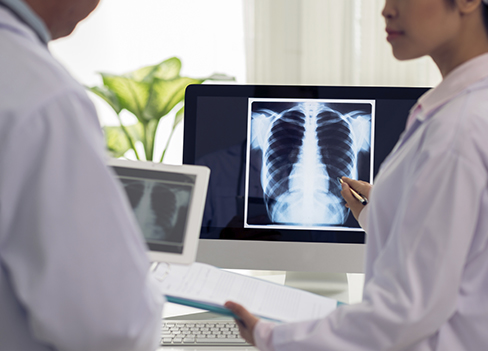Impingement Syndrome

Dr. Laith Farjo explains more about impingement syndrome of the shoulder below.
What is impingement syndrome?
Impingement syndrome occurs when the rotator cuff gets irritated on the undersurface of the acromion. The reason this begins in the first place is a source of some debate. Some people are born with a "hooked" acromion that will predispose them to this problem. Others have rotator cuff weakness that causes the humerus to ride up and pinch the cuff. "Bursitis" is a an older term that we occasionally use to refer to impingement syndrome. This means that the bursa — a water-balloon type structure that acts as a cushion between the rotator cuff and acromion/humerus — gets inflamed.
How is impingement syndrome diagnosed?
Your orthopaedic surgeon or primary care physician can have you perform various maneuvers to detect this problem. In addition, plain x-rays can show a spur on the undersurface of the acromion. An MRI is occasionally ordered if a rotator cuff tear is suspected.
Our first line of treatment is with the prescription of exercises to strengthen the rotator cuff. These can be done by the patient independently or with a physical therapist. We find that patients who do their exercises on their own, at home (in addition to physical therapy, if necessary) are the most likely to be able to avoid surgery. Anti-inflammatory medications (e.g., Ibuprofen, Naprosyn) are prescribed. An injection of a corticosteroid medication into the bursa may also be performed, which helps to decrease inflammation, and therefore, pain, within the bursa. All these forms of treatment are called "conservative", meaning they do not involve surgery.
What happens if impingement syndrome goes untreated?
Many people get mild impingement from time to time and it goes away on its own. People also often respond to treatment with exercise and medicine, as detailed above. Some people will continue to have symptoms and progress to a rotator cuff tear.
What can be done if the "conservative" treatment fails?
The spur on the undersurface of the acromion can be removed, surgically. There are two ways to do this
Open decompression: in open decompression, an incision is made on the front of your shoulder and the spur is removed.
Arthroscopic decompression: in arthroscopic decompression, two or three small incisions (about 0.5 inch each) are made around your shoulder and an arthroscope is placed into the bursa; using specialized instruments, the spur is removed.
What is the recovery after surgery?
For arthroscopic surgery, the recovery period is relatively short. I encourage patients to move their shoulder immediately after surgery, although their arm is placed in a sling for comfort. Cryotherapy can be of help in reducing the pain post-operatively; you should check with your insurance company if they will pay for such a device.
Strengthening exercises are prescribed. For people who work at a "desk job", many can return to work within one (1) week of surgery. Heavy laborers may require a longer time off work.

Our Technology
It may come as a surprise to most people, but much of innovation in the field of orthopedic surgery happens in private practices such as ours, not in universities. Our surgeons utilize the most advanced technologies in treating your problem. They are experts in the field of joint replacement, arthroscopy, foot and ankle surgery, and sports medicine.
Learn More



